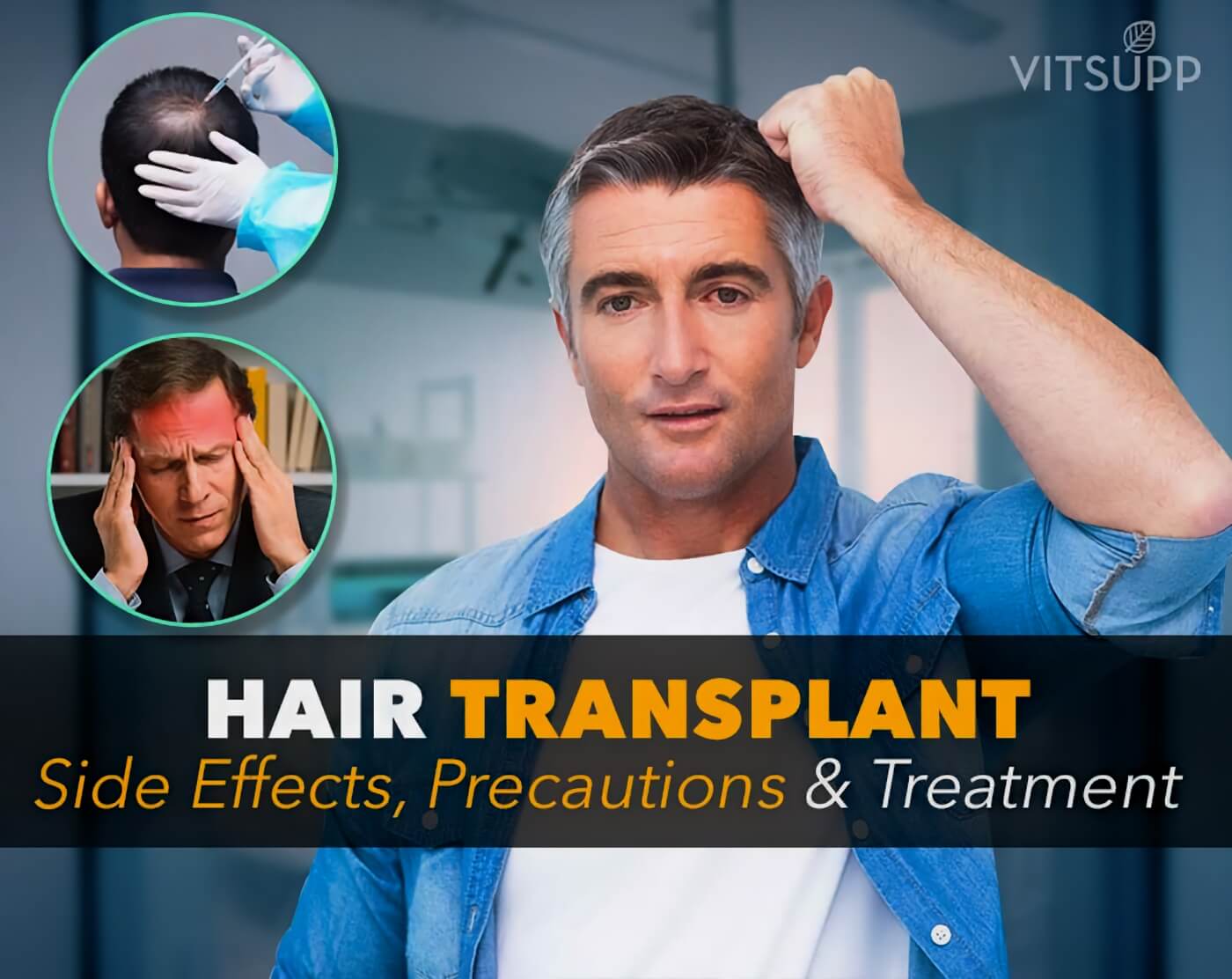The hair transplant surgery is becoming increasingly popular because it can give natural-looking and permanent results. But, even this non-invasive procedure has some risks associated with it. Hence, it is important to consult a qualified professional to understand hair transplant side effects before rushing into the process.
With numerous hair regrowth options to choose from, baldness is a problem of the past. Hair restoration can ease out people’s lives and boost their appearance and self-esteem in the process. A variety of studies conducted state that there is a twofold increase in the people opting for this procedure.
Here is an extensive list of the side effects associated with hair transplant surgery. But first, it is important to understand the nitty-gritty of the process.
Contents
What is hair transplant surgery?
A surgical procedure in which balding areas of the head are implanted with hair from various parts of the body, which are full of hair, such as legs or the back of the head. The procedure doesn’t require any external donor. And, it can work well for both men and women of all ages and races.
It is completely normal to lose about 100 strands of hair per day but losing more than that could result in thinning hair and receding hairline. A number of factors are responsible for hair loss – genetics, poor nutrition, stress, arthritis et al. The surgeon will go through the history of the patient, run some tests and carve out a proper plan for hair restoration. (1)
There are two types of hair transplant procedures. Namely, Follicular Unit Transplantation and Follicular Unit Extraction. More on this below…
Follicular unit transplantation (FUT)
Also known as the strip procedure, Follicular Unit Transplantation is a type of hair transplant or restoration technique. In this procedure, hair from the scalp is taken and then transplanted into follicular units, which are usually in groups of four.
Each follicular unit or group will have to consist of nerves, sebum or the sebaceous oil glands, a small muscles, and fine vellus hairs. The vellus hair is nothing but tiny, thin and small hair that is close to the scalp.
Usually, thousands of hair grafts are transplanted in the scalp of the patient in one single session. Healthy hair from the part of the scalp where hair growth is good, is taken and planted on the areas where hair growth is less. (2)
Follicular Unit Extraction
Follicular Unit Extraction is also known as Follicular Transfer. In this procedure, the back of your scalp is completely shaved. Once this is done, hair follicles from the shaved area of the scalp are extracted once at a time.
The surgeon or haircare professional makes sure that the hair follicles that are extracted have a good chance of survival and growth. Grafts are prepared with this. After that is done, the area that lacks hair growth is cleaned and the patient is administered local anaesthesia.
On the area where hair needs to be transplanted, small slits or holes are made. This is basically a minimally invasive technology. The slits or holes are made with the help of a needle or scalpel. Once this is done, the grafts or follicular units are gently placed into the holes or slits. (3)
Hair transplant side effects
Side-effects could be different for different patients. The fortunate ones can have a trouble-free process but some can experience anything between mild to strong side effects listed below.
1. Edema
Also known as swelling, post-surgical edema consists of the building up of excessive fluid in the tissue. According to a survey published in the International Journal of Trichology, more than 42 per cent of the people who have undergone the hair transplant procedure faced it at some point in time.
Edema of the forehead is the most common and can occur within a week from the surgery. In some cases, patients experience swelling on the eyelids as well. In worst-case scenarios, the swelling is so severe, that the patient might find it difficult to open their eyes.
Most of the surgeons recommend using a headband to prevent edema from spreading to the face. The second best preventive measure, which reduces the risk of spreading, is to spend maximum time in the reclining position. Some doctors may also give short-term oral steroids to remedy the problem.
Administering a solution of tumescent and triamcinolone in the area where the hair transplant has taken place has also proven to be quite effective in preventing edema after the hair transplant surgery. In fact, the application of these solutions is a safe method to prevent swelling and edema. However, in most cases, edema is a temporary side effect and the symptoms can be easily subdued.(4) (14)
2. Infections
Infections, though possible, are a rare occurrence. They happen in less than 1 per cent of the cases. Poor hygiene and negligence while carrying out the Follicular Unit Transplantation (FUT) is the primary reason, which increases the risk of infection.
The chances of getting an infection is high if the tools and materials used during the procedure were not sanitised. Another causal factor of infection is the formation of crusts on the scalp. Crust formation is a result of the build-up of dead skin cells. After a hair transplant procedure, your scalp is more prone to the build-up of dead skin cells. This can lead to an infection.
Sometimes, if you sweat excessively on your scalp after a hair transplant procedure, it can lead to the accumulation of sweat and dirt as well, which in turn can lead to an infection.
One of the most common symptoms of infection is often itching and must not be ignored at any cost. Sometimes, itching can be a sign of healing as well, but make sure that you get this checked by the hair transplant surgeon to avoid any possible infection or side effects. (5)
3. Haemorrhage
The risk of haemorrhage is higher for the people who opt for Follicular Unit Transplantation (FUT). It is because the FUT consists of removing an entire piece of skin from the scalp, which is not the case in other procedures.
A study carried out in the year 2014 stated that less than 2 per cent of the patients suffers post-surgical bleeding. It is an uncommon side effect and is usually caused by medical negligence. It usually takes place a few minutes after the surgery. To stop the affected area from bleeding, the hair transplant surgeon usually cleans the area, and applies gentle pressure on the scalp with the help of a clean, dry gauze. (6)
4. Hair thinning
The thinning of your hair can be quite an ironic side effect, but it is possible. Though expected and completely normal, implanted hair falls out within a month of the procedure. It is called shock loss and is nothing to be worried about.
One can lose up to thousands of hairs during this period and it may take about a month or so for the new hair to sprout. Shedding may also occur because of improper grafting procedure and may even cause permanent hair loss in the patient.
One of the main causal factors of hair thinning is if the hair transplant surgeon made the grafts of hair from a region where the hair growth is not great and if the survival rate of the newly transplanted hair is low. While hair thinning a month or so after surgery is considered normal, you need to bring it to the notice of your doctor if it does not stop or if it continues to thin even after a month or two.
Hair thinning can be prevented by the usage of topical solutions such as minoxidil. (7)
5. Scarring
FUT is a high-risk hair transplant procedure and there is a possibility of formation of a deep and wide scar on the back of the scalp. Scars can appear in more than 16 per cent of the cases and there is a high possibility of them being prominent. In some cases, it may even impact the overall result of the process.
The scars are usually most visible in the areas from where the hair or scalp has been removed, that is, the donor areas. Unlike FUT, FUE and DHI do not involve big incision hence the risk of a single large scar is averted. Though, the possibility of small scars cannot be completely ruled out. (8)
Types of Possible Scarring
Various types of scarring are associated with hair transplant procedures. These are listed below –
- Wide scars: In most cases, this type of scar is caused due to an error during the procedure. It can also take place if the patient has not complied to the directions that were given by the surgeons.
- Crosshatch scars: Sometimes, during the procedure, excess pressure might be involved during the closure process. This can result in a pattern that resembles crosses. To prevent this, the surgeon has to take precautionary measures to avoid snug, overlying staples or sutures.
- Visible scars: This happens to be one of the most common types of scars associated with hair transplant procedures. It can take place if the surgeon has made multiple incisions across both the donor and recipient areas.
- Keloid and hypertrophic scars: This type of scarring is one of the rarest. It takes place if the body has an exaggerated response to the healing process. When this happens, the patient begins to suffer from excessive itching, crust formation, and a sort of pricking sensation in an around the transplanted areas. Usually, steroids are administered to treat this condition. (15)
6. Hiccups
A common side-effect of the hair transplant procedure, 5 per cent of patients suffer from hiccups post the surgery. The exact cause of hiccups is unknown but they can be long-lasting if not treated in time. (9)
7. Numbness
Numbness post the surgery is common and often temporary. It may occur at the area of the transplant or donor area, or both. Different patients experience different degrees of numbness, some may experience it more than others. In most cases, patients experience numbness due to the dosage of anaesthesia that they were administered with.
Some patients may feel slight irritation, tingling, or burning sensation after the procedure, which is a positive sign and indicates healing. But in some other cases, patients may not have any sensation. It is completely natural to be concerned but the numbness may take at least a month to go away. One should consult their doctor immediately if the numbness persists. (10)
8. Cysts
Cysts are pimple-sized lumps, which are benign in nature. Postoperative cysts are common and can be easily cured with medication. The graft area is vulnerable to infection and when the skin is penetrated too deeply, it ends up damaging the hair follicle, causing cysts. However, in some cases, they have to be removed via operation but usually, it rarely happens. (11)
In worst-case scenarios, the cysts might appear around the follicles of the newly transplanted hair. When this happens, the patient might suffer from pain and an itching sensation. To treat this, the cysts are sliced open, and the fluids are removed and cleaned. Topical antibiotics are applied as well, to prevent infection and provide relief from pain. (16)
9. Bleeding
Bleeding is a common side-effect of hair transplant surgery. Most patients notice some amount of bleeding on both donor and recipient site after the procedure. It lasts for about 15 days after the procedure and it can be easily managed and minimised. Applying pressure can reduce bleeding. A clean gauze is gently placed on the bleeding area, and pressure is applied. In rarest of rare cases, one needs a stitch or two to stop the bleeding. (1)
FUE hair transplant side effects
The follicular unit hair transplant procedure is a relatively safe procedure, however, you may face a few possible side effects. These side effects are listed below –
- You may experience bleeding soon after the surgery. In the follicular hair transplant surgery procedure, the back of your head will be shaved, after which the hair follicles will be extracted. However, extremely small microneedles are used both for extraction and transplanting. So, the bleeding is usually minimal, if any.
- If the instruments used were unhygienic or if there was an error in the process, you might get an infection.
- Swelling is another common side effect that comes with not just follicular unit transplant but with other hair transplant procedures as well
- In some cases, you may experience crust formation.
- Itching and inflammation of the scalp, particularly after the formation of crusts. (17)
Artificial hair transplant side effects
Also known as bio fibre hair transplant or synthetic hair transplant, this procedure involves the implantation of artificial or bio fibre hair into your scalp. Unlike follicular unit extraction and follicular unit transplantation, bio fibre hair transplant is not the most popular choice as it is not very safe. Let us look at the side effects –
- You may suffer from an extreme case of scarring. This takes place because artificial hair is inserted into the scalp
- Moderate to severe allergic reactions
- In most cases, it will give you an artificial appearance, and the hair will look more like a wig than natural hair.
- You may end up suffering from constant pain.
- Brushing your hair or even strong winds could remove the transplants or damage them. (18)
In conclusion
All medical procedures have risks and one should do thorough research before deciding to go for it. Oftentimes doctors prescribe painkillers and topical creams to reduce the discomfort. The discomfort is temporary and shouldn’t last for too long. Fortunately, there are no long-term side effects associated with hair transplant procedures. To avoid pain and discomfort, one should follow the doctor’s advice and abstain from drinking and smoking for optimal results.
It may take around 9 months for the full effects of hair transplant to be visible and it is important to be patient. Take care of hygiene and avoid high-intensity workouts for some time. Consult a doctor immediately if any of the above symptoms persist.
What are the side effects of hair transplant?
Following are the side effects of Hair transplant surgery:u003cbru003e1. Edema u003cbru003e2. Infections u003cbru003e3. Haemorrhage u003cbru003e4. Hair thinning u003cbru003e5. Scarring u003cbru003e6. Hiccups u003cbru003e7. Numbness u003cbru003e8. Cysts u003cbru003e9. Bleeding


